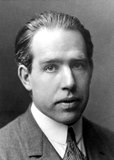Atom

The atom is the smallest building block of any chemical element. Its name is derived from the Greek word atomos (ἄτομος), meaning "indivisible".
History
The Greek philosopher Democritus of Abdera (ca. 460 BC – ca. 356 BC) postulated that all being consists of atoms that are indivisible and unchangeable. Atoms form a number of combinations and between them there is empty space.
In 1808, the English physicist and chemist John Dalton (1766 – 1844) published the following theory:
- elements consist of atoms
- atoms of the same element have the same mass
- atoms of different elements have different masses
- atoms themselves never change
What atoms consist of, Dalton did not know.
According to the model of the Danish physicist Niels Henrik David Bohr (1885 – 1962), the atom consists of a positively charged nucleus, which is composed of positively charged protons and uncharged neutrons, surrounded by a cloud of negatively charged electrons. The electron orbits are organized in shells that, counting from the nucleus, are indicated by the letters K, L, M,...
The number of electrons, the atomic number (Z), determines which chemical element is involved: for hydrogen (chemical symbol: H) is Z = 1 and for lead (chemical symbol: Pb) is Z = 82.
In some nuclei, a proton may turn into a neutron, or vice versa. Such nuclei are unstable and show nuclear decay. Electrons can change orbits and releasing energy can lead to the emission of electromagnetic radiation in the form of light and X-ray photons. In both cases ionizing radiation is created that may harm our health.
Related concepts
| Last modified: | 11 April 2024 11.29 a.m. |
